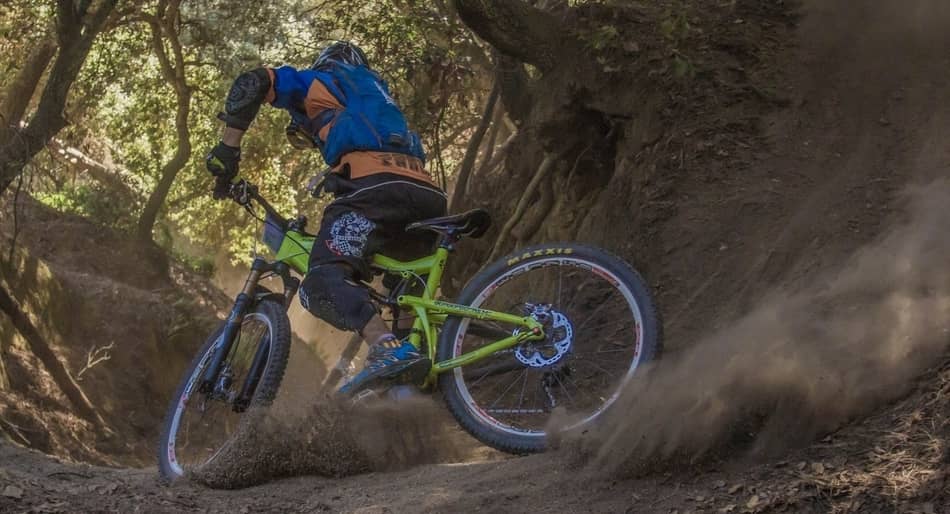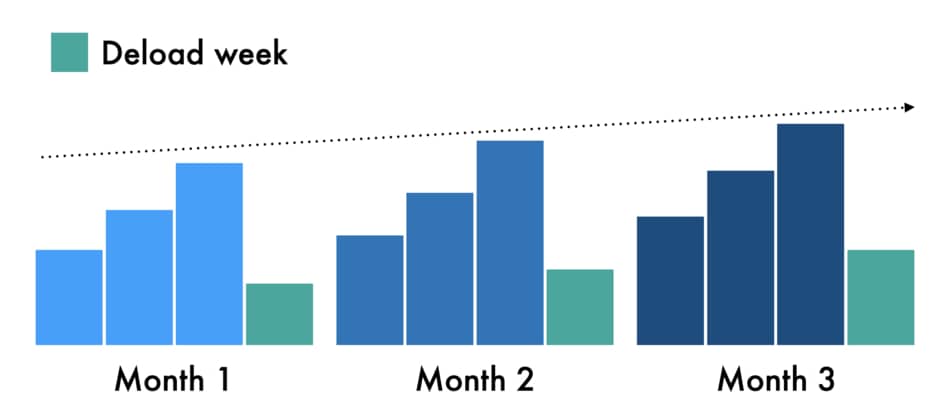A peloton is a great tool not only to get in shape but also to maintain your fitness level, especially if you train for a specific sport like mountain biking. In this article, I will explain if peloton is good for MTB, and if so, which classes are worth your time.
As a whole, the peloton is good for mountain bikers because it helps to build up muscle strength and endurance during the off-season. It also has several classes that help prevent common mountain biking injuries, like knee pain and lower back pain.
I think that peloton is the best exercise bike for mountain bikers because it can be used as a workout machine as well as an assessment tool to help you plan your training and track your progress (more on that in a second).

Best Peloton Classes For Mountain Bikers
One of the best ways to improve your MTB performance is to spend more time on the bike. Nothing improves the technical bike handling skills like a trail practice.
However, there are a lot of things you can do at home with the peloton to work on your fitness and stamina.
Does peloton help mountain biking? As a whole, the peloton does help mountain biking because it includes workouts like climb rides, interval rides, and low impact rides that help to prepare for the season. It also has many strength workouts that help to fill out the gaps.
Many professional mountain bikers like Jolanda Neff, Nino Schurter, or Kate Courtney do strength and conditioning together with their trail practice. It helps to become more powerful and resilient.
Does Peloton have mountain biking classes? Overall, the peloton doesn’t have specific mountain biking classes. However, it does have many scenic rides from epic locations like Maui, France, or Australia filmed with multiple camera views.
You can read more about “how does peloton film their scenic rides” in my article here.
Here are some of the best peloton classes that you can use for your MTB practice.
#1 Power Zone Endurance
Power zone endurance rides help to train at a moderate pace over a long time. This allows to bump up the overall mileage. Those rides shouldn’t feel too strenuous as your main goal is to build up your endurance.
Long and steady rides are the foundation of mountain bike training.
Why power zone endurance is good for MTB? Overall, the peloton power zone endurance rides are good for mountain bikers because they allow improving the stamina without overtraining. Classes last between 30 to 90 minutes and are mainly done within power zone 2 and 3, which is the most optimal intensity for aerobic endurance.
What are power zones? Power zones are the intensity levels that allow you to track your effort level. Apart from being an exercise tool, the Peloton bike is also an assessment equipment thanks to the built-in power meter.
You can learn more amount “peloton power zone” training here in my article.
This type of class is perfect for people who just getting started with the MTB, or for the pros who are looking for ways to maintain their training volume in the offseason.
You can monitor your intensity using the power bar directly from the bike. You also have access to the metrics and workout history, which is easy to keep track of your progress.
For beginners, I recommend doing 2-3 power zone endurance rides per week, starting from the shorter rides (30 minutes). After a couple of weeks, slowly increase the duration while keeping the same number of sessions.
I also recommend having at least one day per week where you can do longer rides (75-90 minutes).
#2 Low-Impact Rides
Peloton low-impact rides are another way to increase your training volume, without causing muscle fatigue. Those classes are generally shorter (20 minutes) which can be used on the days off, recovery days, or together with strength training classes.
Why low impact rides are good for MTB? In general, the peloton low-impact rides are good for MTB because they help to maintain training volume while improving the recovery. They also can be used during the deload period where you reduce your intensity for the whole week.
What is the deload period? Overall, the deload week is the period of training where you reduce training volume and intensity from your workouts. The deload week helps to relax, avoid overtraining, and come back stronger the following week.
Deload is widely used in periodization to maximize training adaptations and prevent the onset of overtraining. This is not about taking the week off. This is about changing your routine and doing something different with lower intensity (e.g. walking, low-impact ride, or yoga).
Here is an example of how to use deload in mountain bike training.

First 3 weeks of each month you gradually increase the intensity and/or duration. In the last 4th week, you start deload where you reduce intensity.
After your recovery week, you start the cycle again by adding 5-10% more training volume compared to the previous month.
NOTE: Deload is also a good time to work on your nutrition, stress management, and sleep.
#3 HIIT Ride
High-intensity interval training is another important component of an effective mountain bike training plan that helps to improve your anaerobic power and stamina.
Typical peloton HIIT ride involves doing 1 to 3 minutes of hard effort where you add more resistance, followed by 1 to 2 minutes of recovery time.
During the maximum effort, your heart rate should be elevated to the point where maintaining a conversation is impossible. These are very short and very high-intensity efforts.
During the rest time, you reduce your intensity, slow down the pace but continue to cycle. The whole class takes 20 to 30 minutes.
You can filter each session by its difficulty level. Beginners will usually have a higher recovery-to-work ratio, where advanced is around a 50/50 split.
Why peloton HIIT ride is good for mountain bikers? Overall, the peloton HIIT ride is good for mountain bikers because it helps to improve the anaerobic threshold, VO2 max, and lactate tolerance. Having good anaerobic capacity also allows climbing more steep hills for longer without feeling muscle fatigue.
What is anaerobic capacity? As a whole, the anaerobic capacity increases the tolerance to lactic acid and allows to maintain a high-intensity effort for longer. It is also the ability to eliminate lactic acid more efficiently from the body, which helps to recover more quickly from challenging workouts.
In other words, higher intensity workouts are important, but they shouldn’t be done back to back. I recommend doing 1-2 days of HIIT rides per week. The rest of your MTB training focuses on endurance.
This way you can progress and maximize training adaptations, without the risk of overtraining.
#4 Climb Ride
Peloton climb rides are my favorite MTB training classes because it helps me to be more comfortable out of the saddle. Mountain biking is all about standing position and being able to balance your weight, whenever you’re riding drop-offs or climbing steeps.
This can be problematic, especially for beginners because when you’re changing position, the body changes biomechanics. It allows generating more power output by using more muscles, but it also requires more energy.
Why climb ride is good for MTB? In general, the peloton climb ride is good for mountain bikers because it helps to build up the strength in quads, glutes, and shoulders to sustain constant power during a standing position. It also engages the core and stability muscles that work during the hill-climbing.
On the other hand, climbing in a seated position is easier and more comfortable. However, it is much slower and less efficient.
I prefer being out of the saddle because it makes me feel like I’m doing more work in a shorter time.
#5 Full Body Strength
Peloton full-body workouts are one of the most versatile classes available in the library. You can use it to enhance any fitness goal from marathon training to weight loss.
Does peloton strength help mountain biking? As a whole, the peloton full-body strength does help with mountain biking because it helps to address some of the weaknesses that riding the bike cannot tackle like improving ankle mobility, better glute activation, or core stability.
It builds muscular strength in the whole body, prevents injuries, and increases bone density.
Bone density is also important because riding the bike is generally considered a non-weight bearing (NWB) exercise. Adding weight training helps to fill that gap.
It also targets the muscles that are not typically used during mountain bike rides.
There are several peloton strength classes to choose from:
- Upper body strength
- Lower body strength
- Full Body strength
- Pilates
- Core training
As you can see, in the peloton strength classes you can always choose to focus on the area that you feel you need the most. Plus, they only last for 15-30 minutes.
Not only that.
Studies have shown that adding activities like running or strength training has a cross-transfer effect and can improve your mountain biking skills (Millet et al. 2002).
What is the cross-transfer training effect? As a whole, the cross-transfer training effect is the improvement in performance in a given activity (e.g. MTB) from doing other exercises or activities (e.g. weight training). Progression in one discipline helps to improve the performance of others.
In other words, doing all variety of peloton classes like cycling, strength training, cardio, and even walking can help to develop a well-rounded physique and maintain your fitness year-round.
One thing I love about the peloton strength is that you can mimic gym workouts without going to the gym. This is perfect for people who are busy and don’t have time to commit to the gym.
Conclusion
As you can see, the peloton bike can be a great alternative for MTB training, especially during the offseason time. Thanks to a large selection of classes you can design your entire training plan without leaving your home.
Of course, there’s no substitute for miles in the saddle. But for people who have a busy lifestyle and cannot get out on the trail as much as they would love to, the peloton is a great solution.
